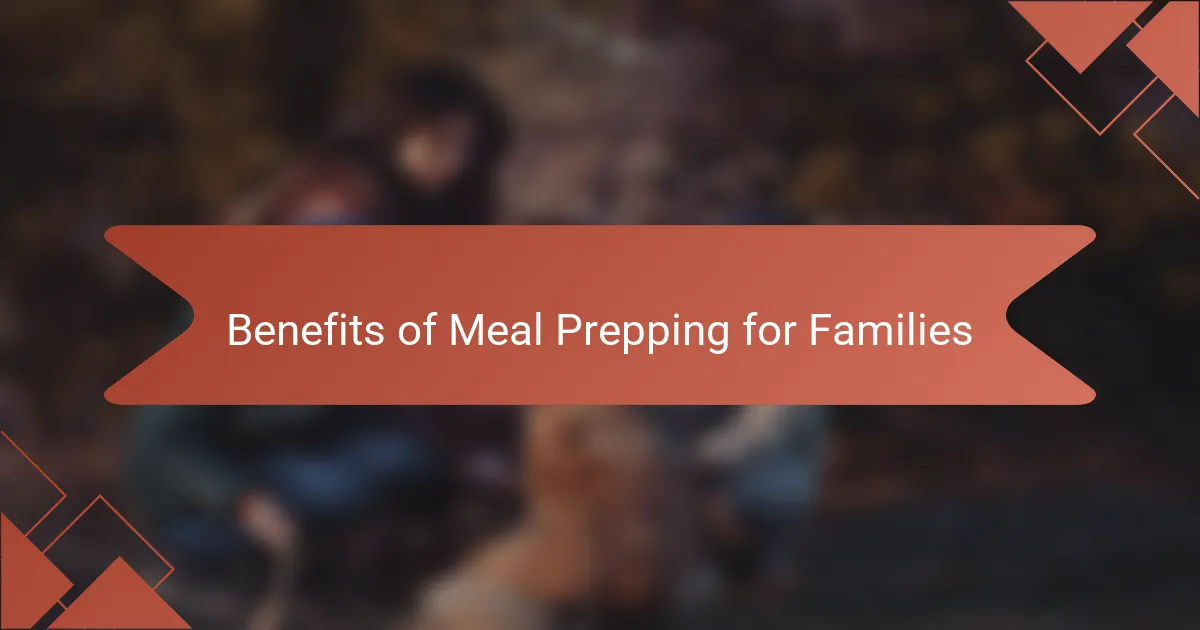Key takeaways
- Meal prepping allows families to enjoy healthier meals and reduces the stress of last-minute cooking decisions.
- Essential tools include durable containers, a sharp knife, and a slow cooker to enhance the meal prep experience.
- Planning meals around the week’s schedule helps ensure enjoyable and efficient meal preparations.
- Proper storage and reheating techniques keep meals fresh and flavorful, enhancing the overall meal prep process.

What Is Meal Prepping
Meal prepping is simply the act of planning and preparing your meals ahead of time. It’s something I started doing when my week felt overwhelming, and suddenly, those busy evenings didn’t have to mean scrambling for dinner ideas. Have you ever wondered how some families manage to stay so organized with meals? That’s meal prepping in action.
For me, meal prepping isn’t just about saving time; it’s about creating a sense of control and calm around food. When I prep, I’m not just chopping veggies or cooking proteins—I’m setting myself up for healthier days and less stress. It’s a small act that makes a big difference in how the whole family feels about mealtime.
Think of meal prepping as your personal food game plan. You decide what’s coming and when, which means no more last-minute “what’s for dinner?” panic. This simple habit quickly became my secret to juggling family life without sacrificing nourishing meals.

Benefits of Meal Prepping for Families
One of the biggest benefits I’ve noticed with meal prepping is the extra time it frees up during the week. Instead of rushing around after work, I can actually relax with my family, knowing dinner is already taken care of. Have you ever experienced that frantic evening scramble that just zaps your energy? Meal prepping wipes that out completely.
Meal prepping also helps me keep us all on a healthier track. When I plan and prepare meals ahead, I’m able to control ingredients and portion sizes, which means fewer unhealthy takeout nights. It feels good to know I’m nourishing my family with balanced meals, without the stress of last-minute decisions leading to junk food.
Besides the practical perks, meal prepping brings a surprising sense of calm and togetherness. When meals are ready and waiting, we focus more on connecting around the table rather than worrying about what’s on the plate. It’s like I’m gifting my family both time and peace, and honestly, that’s priceless.

Essential Tools for Meal Prepping
When I first started meal prepping, I quickly realized the game-changer was having the right containers. Durable, stackable containers with airtight lids keep meals fresh and make organizing the fridge so much easier. Do you know that feeling when you rummage through your fridge and everything is a mess? Having a neat system with these containers cuts down on that daily chaos.
Another tool I swear by is a sharp chef’s knife. I used to dread chopping vegetables because it felt slow and tiring, but once I invested in a good knife, prepping became surprisingly enjoyable. There’s something satisfying about how quickly and safely I can get through my chopping when I’m equipped with the right blade.
Lastly, I can’t overlook my trusty slow cooker. On busy days, I toss ingredients in, set the timer, and come back to a hot, ready meal. It’s like having a personal sous-chef that lets me focus on family without sacrificing homemade goodness. Have you tried a gadget that makes your life this much easier? For me, it’s been a total lifesaver.

Planning Your Weekly Meals
When I plan my weekly meals, I start by taking a quick glance at the calendar to see what kind of days lie ahead. Do I have back-to-back appointments, or will there be a leisurely evening for cooking? Knowing this helps me decide which meals need to be quick and which can be a bit more elaborate without throwing off my whole routine.
I also jot down a list of meals that the whole family genuinely enjoys—because what’s the point of prepping food that ends up forgotten in the fridge? It feels good to know we’re all looking forward to dinner, and it saves me from wasting food or feeling stuck in a meal rut. Have you noticed how a well-planned menu makes grocery shopping so much more straightforward too?
Sometimes, I mix in one new recipe each week just to keep things interesting. It’s a little challenge that keeps my meal prepping from becoming a bore. Trying something fresh not only spices up our dinners but gives me a nice sense of accomplishment when it turns out well. Wouldn’t you agree that variety makes meal prep feel less like chore and more like a creative outlet?

Step by Step Meal Prep Process
First, I gather all my ingredients and lay them out on the counter, almost like setting the stage for a cooking show. It’s funny how this simple act instantly makes the whole process feel more manageable and even a bit exciting. Have you ever noticed how having everything within reach somehow glides the prep along?
Next, I break down the tasks into bite-sized steps—chop the veggies, cook the grains, roast the proteins—one at a time rather than trying to do it all at once. This keeps me from feeling overwhelmed and gives space to actually enjoy the process, like a mini cooking meditation. Do you think multitasking always saves time? I’ve learned the opposite sometimes holds true when meal prepping.
Finally, I portion out the meals into containers, labeling and stacking them neatly in the fridge. There’s something deeply satisfying about closing that fridge door, knowing the week ahead just got a little easier. Doesn’t it feel like a small win when you see those ready-made meals staring back at you? For me, that moment always brings a sigh of relief.

Tips for Storing and Reheating Meals
One thing I’ve learned is that how you store your meals can make all the difference in freshness and taste. Using airtight containers is a non-negotiable for me—nothing beats that feeling of opening a container and still smelling the vibrant flavors from earlier in the week. Have you ever pulled out soggy or freezer-burned leftovers? That’s what I’m trying to avoid by sealing in moisture and flavor right from the start.
Reheating meals is another small art that I’ve had to master. I often reheat on the stovetop or in the oven instead of the microwave—it takes a little longer, but the texture stays closer to freshly made. When time is tight, I cover containers with a damp paper towel in the microwave to keep things from drying out. Have you tried this trick? It makes a surprising difference!
Also, I’m a big proponent of letting food cool completely before popping it in the fridge or freezer. I used to rush this step, and everything ended up soggy or weird the next day. It sounds simple, but trust me, waiting just a bit preserves the integrity of flavors and helps food reheat better. Isn’t it funny how these little habits can turn you from meal-prep rookie to pro?